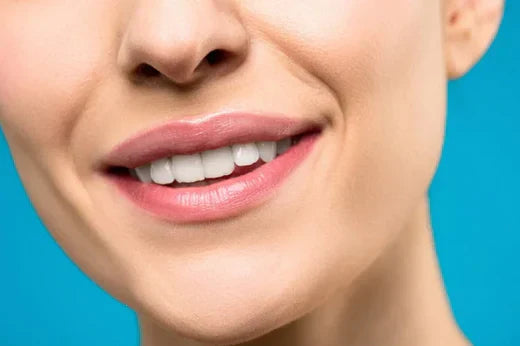
Table of contents
- Clear Aligners
- How to Use the Clear Aligners
- Are Clear Aligners Painful
- Where to Buy Clear Aligners
- Aligners vs Retainers
- Porcelain Veneers
- Restorative Crowns
- Dental Bonding
- What Dental Bonding Can Fix
- Is Dental Bonding for You
- The Process of Dental Bonding
- Cost of Dental Bonding
- Palatal Expanders
- Other Techniques
- Natural Teeth Straightening: Myth or Reality?
- Cost Comparison: Braces vs. Alternatives
- FAQs
Misalignment of teeth is one of the biggest dental issues in the United States. Over 59% of the US population needs some kind of orthodontic treatment.1 These can be overbite, underbite, crossbite, or spacing issues. These imperfections will impact your smile and kill your confidence.
The common solution was to wear braces—weird metallic wires—for months and even years. They are painful, uncomfortable, and expensive. Moreover, due to their visible appearance, they can also become a cause of embarrassment at any gathering. Imagine someone noticing a set of wires in your mouth while listening to you.
With the advancements in Orthodontic technology, you can now fix crooked teeth without braces. There are painless, comfortable, and cheaper ways to straighten your teeth. These methods require fewer dental checkups, less time to straighten your teeth, and come with zero dietary restrictions.
Clear Aligners
Aligners are the very first thing that comes to mind when we talk about straightening teeth without braces. These are a series of transparent plastic trays, custom-made for you. They work by putting gentle pressure on the teeth forcing them to get into the right shape.

How to Use the Clear Aligners
The process of installing and removing aligners is very simple. Just pick up your aligners and put them in your mouth. Since they are custom-made for you, there is no issue of adjustment or sizing. Clear aligners are generally replaced with a new tray every two weeks.
You have to wear them for 20-22 hours a day. Simply remove them before eating and brushing your teeth. Whereas food particles can get stuck in the wires of braces, aligners allow you to eat anything comfortably. And since they are invisible you can wear them anywhere without anyone noticing.
Are Clear Aligners Painful
Aligners are not painful in general. But you might feel mild tenderness or soreness in the first few days, or when you switch to a new tray. If you feel something like this, it means your aligners are working. For the first time, this will take only 4-5 days to heal and a day or two when you change the tray.
Where to Buy Clear Aligners
Most dentists now offer clear aligner treatment in their offices. However, if you want to avoid the long queues there are many aligner provider companies in the market. ALIGNERCO, one of the most trusted names in the industry, has helped over 10,000 people achieve a perfect smile. With a trust rating of 4.3 and over 3000 reviews on TrustPilot, ALIGNERCO offers two types of aligner treatments to suit your needs—All Day & NightOnly Clear Aligners.
| Plan Type | All-Day Aligners | NightOnly Aligners |
|---|---|---|
| Description | Invisible aligners for at-home teeth straightening. | Clear aligners are worn during sleep for convenient treatment. |
| Wear Duration | 20-22 hours/day | 8-10 hours/night |
| Treatment Duration | 4-6 months | 6-8 months |
| Visibility | Almost invisible | Worn during sleep, not visible during daily activities |
| Removability | Can be removed at the customer’s convenience. | Worn only at night, allowing normal daily routine. |
Aligners vs Retainers
There is a common misconception about the use of clear aligners and retainers. Clear aligners are used to straighten the teeth while clear retainers are used to keep your teeth straight once you have undergone an orthodontic procedure. In layman's terms, retainers don't straighten your teeth but they help them stay straight.
Porcelain Veneers
Another way to straighten teeth without braces is veneers. Veneers are custom-made shells to cover and enhance the appearance of the front of the teeth. They can be used to alter the color, shape, size, and length of the teeth.

Are Vene ers Right for You
If some of your teeth are misaligned, damaged, or discolored because of stains, veneers are for you. But if you have multiple crooked teeth, aligners might be the best choice.
What’s the Process
The dentist removes a small amount of your enamel and takes an impression. The veneers are made in the lab and then glued to your teeth. Veneers are semi-permanent and they have a life span of 10-20 years.
Cost of Veneers
Veneers for crooked teeth are an expensive option. It's $250-$2500 for a single tooth depending on the type of veneers you choose. But it makes your teeth look naturally straight.
Restorative Crowns
Restorative crowns are caps that cover the entire tooth to restore its shape, size, color, strength, and appearance. Crowns can be made of porcelain, metal, resin, or a combination.

What Are Crowns Used for
They can protect your tooth from breaking and provide support to a cracked tooth. They can also cover the tooth with a large filling if your natural tooth is not left enough. If there are any issues with the root, crowns can be used for a dental implantation. Crowns can also replace a completely broken tooth.
How Crowns Are Placed
A cosmetic dentist removes a significant amount of your enamel, to create space for the crown. Since the crowns cover your whole tooth, there is more space required. An impression is taken and your crown is made in the lab. A temporary crown is placed until your permanent crown is ready. The permanent crown is then glued to your tooth.
Cost of Crowns
Crowns can cost $500-$3000 per tooth, but the cost can vary based on the dentist’s experience and the state you live in.
Dental Bonding
Dental bonding is a cosmetic process of applying tooth-colored composite resin to rebuild or enhance the appearance of the tooth.
What Dental Bonding Can Fix
Bonding can be used to fix:
- Cracks and gaps
- Change the shape and size
- Improve the aesthetics
- Protect exposed roots caused by gum recession.

Is Dental Bonding for You
Dental bonding is one of the most common procedures in the dental world. The dentist will ask about your cosmetic goals. He may want to see your dental X-rays to check if you are eligible or not. If you have some serious oral health issues, tooth decay, or gum diseases, you might have to treat these first.
The Process of Dental Bonding
If you are eligible, a weak acidic gel or conditioning liquid is used to roughen the surface of your teeth. Composite resin matching your teeth color is then applied, molded, and shaped to get the desired look.
Cost of Dental Bonding
Dental bonding can cost from $150 to $600 per tooth.
Palatal Expanders
Palatal expanders are used to straighten the teeth of patients with a narrow upper jaw or crossbite. They are generally used to straighten the teeth of children without braces. Adults can also use it, but it works best for children from 8 to 10 years of age.

How Do Palatal Expanders Work
It is a dental instrument to be placed in the mouth, linked to the upper jaws. Patients may have to wear it for a few weeks, months, or even a whole year, depending on the complexity of their teeth. Palatal expanders can widen the upper jaws without any surgical treatment. It applies force to your upper jaws to challenge its natural growth potential.
Cost of Palatal Expanders
There are removable and fixed palatal expanders available in the market. They can cost anywhere from $1000 to $6000.
Other Techniques
Teeth Contouring and Reshaping
Teeth contouring and reshaping is a quick fix for slight dental issues. In this process, a small amount of enamel is removed from your teeth to change their shape and size. If your teeth are larger, overlapping or there are slight chips or cracks, contouring is the best procedure to fix that. It is only for minor cosmetic adjustments, and it is not recommended for serious dental issues.
Orthodontic Surgery
Orthodontic surgery is a surgical process to fix major dental issues like issues in the skeleton that affect the alignment of teeth and jaws. Remember orthodontic surgery is the last option for any dental treatment. There are other techniques and alternatives for simple dental issues. But for complex problems, for example, impacted wisdom teeth, severe cases of periodontitis, jawbone issues, or oral cancer, it's the only choice.
Orthodontic surgery is expensive in the USA. Depending on the severity of your issue, your location, and your dentists it can cost from $3000 to $50,000 or even more.
Natural Teeth Straightening: Myth or Reality?
There are myths about natural teeth straightening at home using finger pressure, tongue pressure, or rubber bands. Any experiments with your teeth at home can be dangerous and These methods won't give you a noticeable result. These at-home techniques can lead your teeth to lose, chipped, or crooked.
ALIGNERCO has a perfect and safe solution to straighten your teeth at home without braces. Our aligners can straighten your teeth at home, under the supervision of expert dentists.
Here is what customers have to say:
Simple and Easy
The process was very easy and convenient for me. The customer service was top notch answering all of my questions throughout the program. I recommend this to anybody who wants to have their teeth straightened.
Brian Rhoades
Indiana

Was very excited for this entire process!
After I sent the molds in, it took a few weeks to make all my retainers. As soon as I got them, I popped the first set in. Was expecting them to be more painful. Then I took them off and realized that some of my teeth were a little sore. It was working! The soreness would last for 1-3 days. It’s expected, your moving your teeth! I was excited for every time I changed my retainers, I step closer to straight teeth! I’m on my final retainers which you wear for 6 months. I have 2 more to go. My teeth look great and my bite feels good!
Jessi Dullinger
AK (Alaska)

Cost Comparison: Braces vs. Alternatives
All the methods and procedures above are typically more cost-effective than braces. Generally, braces cost from $3000-$7000 but it can vary. Here is the cost comparison for each of these methods.
| Procedure | Cost | Difference with braces |
|---|---|---|
| Aligners by ALIGNERCO | $795-995 | $2000-$6000 |
| Porcelain Veneers | $250-$2500 | $2750-$5500 |
| Restorative Crowns | $500-$3000 | $250-$4000 |
| Dental Bonding | $150 to $600 | $2850-$6400 |
| Palatal Expanders | $1000 to $6000 | $2000-$1000 |
FAQs
1. Is it possible to straighten teeth naturally at home?
Yes, it is possible to straighten teeth naturally at home only if you undergo an expert-proven dental procedure like clear aligners by ALIGNERCO. The myths like using rubber bands or applying pressure using your fingers or tongue, won't give you a noticeable result. In fact, it can damage your teeth.
2. What’s the cheapest way to fix crooked teeth?
It depends on the severity. If a few of your teeth are crooked the veneers, crowns, and dental bonding can be effective. But if you have many misaligned teeth, aligners are the best choice.
3. How long does it take to straighten teeth with aligners?
It generally takes 4-6 months, but it depends on the severity of your misalignment.



